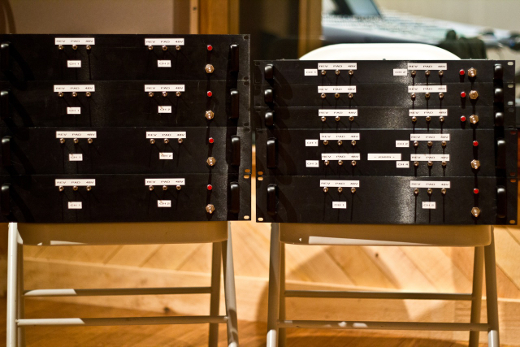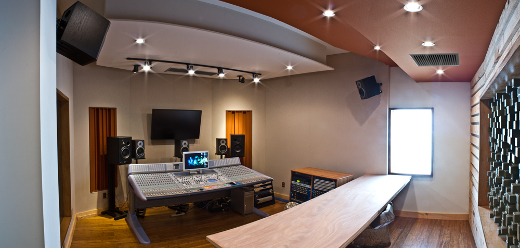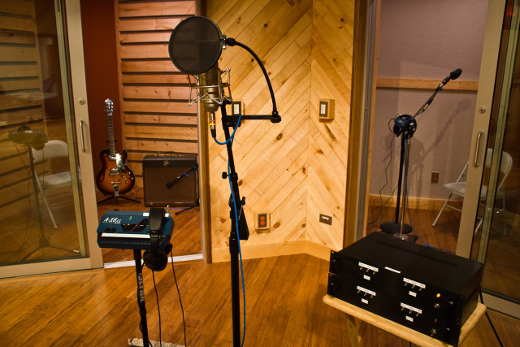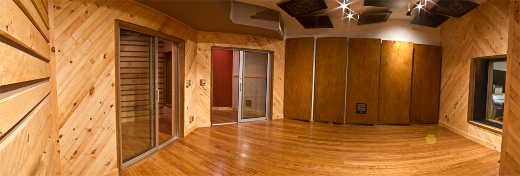Making a Studio Statement: Kaleidoscope Sound Opens The Patio
Some studios just refuse to sit still.
Case in point is Kaleidoscope Sound, the ambitious facility operating from Union City, NJ. Founded by Randy and Amy Crafton, and Sal Mormando, in 2001, Kaleidoscope is a studio that’s also smart about its business – it constantly evaluates what’s working best, and how to maximize what it can do for its clients.
Now the studio, which is just minutes from Manhattan yet feels like a peaceful getaway from the city, has added on to its list of attractions.
Fran Manzella Returns
Kaleidoscope had already been winning fans for its Fran Manzella-designed Studio A control room, which features a pristine 48-channel API Legacy Plus console and adjoining 600-square foot live room. Richie Havens, Bill Frisell, Mingus Big Band, Duke Ellington Legacy, Dayna Kurtz, Diane Reeves, and Ray Barretto, are all part of the clientele that have gravitated there over the years.
Now that room is joined at Kaleidoscope by The Patio, which serves as a versatile Studio B that significantly expands the facility’s offerings.
Fran Manzella returned to Kaleidoscope to design The Patio, providing the 325 sq. ft. live room and adjacent 5.1 Surround Sound, ICON-equipped control room with it’s own aesthetic. The trademark Manzella slatted wood treatments are readily apparent, while brighter treatments clearly differentiate it from Studio A across the way.
With the Patio, Kaleidoscope is now able to provide the clients that call with an in-house option to Studio A, which has enjoyed solid bookings for some time now. The new room is also more affordable, which helps open it up to additional tracking/mixing business, emerging artists, and quick overdub sessions, as well as a fresh sector of audio post clients.
A Flexible Addition
The versatility starts in the control room, centered around a 32-channel Digidesign ICON D-Control with XMON. Built right in is 5.1 Surround Sound mixing capability, courtesy of a quintet of Dynaudio BM5A monitors and a 10” BM9s subwoofer. Two Dynaudio BM15A mains handle stereo duties.
But don’t let the ICON fool you: This is a hybrid digital/analog space constructed by people who love the sound of API. Three lunchboxes sport vintage API 550 EQs; custom-racked vintage API 312 pres and Universal Audio 1108 pres are on hand; an API 8200 summing mixer is there; as is an API 2500 Stereo Bus Compressor to lay across the two-mix.
Getting inside the box, dual Lynx Aurora 16 HD converters connect to Pro Tools HD with plugins from Waves, Avid, SoundToys, and Sonnox onboard.
Analog Front End, Digital-Friendly
The first iteration of Kaleidoscope’s Studio A featured a Millennium Falcon of a custom console, built out of the aforementioned vintage API and Universal Audio mic pres and EQs. Beautiful to listen to but a pain for outside engineers to learn, the juggernaut was eventually dismantled to make way for the 48-channel API.
Randy Crafton wisely put most of the modules into storage, figuring that he’d get a chance to use them again sooner or later. Now they’ve come in handy, pressed happily into service in The Patio.
“Studio A is the old-school vintage room with the API, tons of outboard gear, the EMT plate, and the AKG spring reverb,” explains Studio Manager/Staff Engineer Kyle Cassel. “The Patio is a digital-friendly room, and it can do what Studio A can’t necessarily do, with its surround sound capabilities.
“It just made sense to use the old API and Universal Audio preamps for The Patio. Even though the room was planned to be more of a post-friendly/digital type room, we still wanted to incorporate as much vintage analog gear as we could, especially with the pres and 550s. I think that aspect really sets it apart. We’ve also installed an API 2500 stereo bus compressor in The Patio as well. We’ve all ended up using that compressor so much on the console in Studio A, it was a no-brainer for the new room.. So you’ve got the ICON, you’re using plugins, but you can do analog summing with the API 8200. You can get the best of both worlds.
“For tracking, mixing and audio post for TV and film, the control room, is a really, really accurate-sounding room. I’ve been doing some mixing projects there, and it translates unbelievably well.”

(l-r) Vintage, custom rack-mounted API 312 and Universal Audio 1108 mic pres distinguish The Patio’s signal path.
Pristine Mic Pres
The vintage API 312 and Universal Audio 1108 pres in the Patio were custom rack-mounted by NYC/NJ-area freelance tech Ricky Begin. No trim knobs are connected to the pres – instead the unit has only an input pad, phase reverse and phantom power in line, topped with a basic faceplate. In addition, the pres have been placed in the live space, and not the control room.
“These pres sound the best wide open.” Cassel says. “There’s no trim or gain pots on the preamps, only an input pad. We’re also using the Little Labs Red Clouds in the control room, a passive line attenuator box that we can use to control level to Pro Tools. It’s a little different flow, but it’s worth it to get the added sonic benefits of having the preamps in the live room. It takes a second to get used to, but it definitely makes a difference.”
“Inspired by Walter Sears’ thinking, the preamps are set up in the live room, that way you have the shortest distance from the microphones to the preamps. We then have the line level signal going from the pres, to the wall panel, into to the control room. Working this way, the long cable runs carry the stronger signal strength, resulting in better signal quality. From there, its normalled straight into the Little Labs Red Clouds followed by the API 550a lunchbox modules in the control room, so it’s sonically like an API console.”
Live Options
In the live room, Manzella achieved a very even sound. “It’s not quite as big as Studio A, but it definitely has its own vibe,” says Cassel. “It sounds tight wherever you are in the room. Drums feel really good in there. It is, of course important that they sound good, which they do, but when it also feels good to play in a room, it’s inspiring. This room makes me want to play drums.”
While both of the iso booths feature 9’ ceilings and sight lines between each other, they’re not identical. “The one on the right is smaller and more of a dead room,” Cassel states. “The other one is more live, with the slatted wood treatments on the back wall. So for an open sound, you may use the bigger room, and for a vocal that’s more dry, you’d probably want to use the smaller room.”
Sibling Studios
While technical prowess abounds at Kaleidoscope Sound it’s the positive, service-oriented atmosphere that completes the place. A lounge, kitchen, and bath are all onsite, while the peaceful neighborhood surroundings have plenty of restaurant gems nearby.
The addition of the Patio brings an added dimension to a hard-working NYC-area studio. “We’ve had good success with Studio A, and want to continue to build on that,” Kyle Cassel says. “Now we have two significantly different studios, each has its own vibe, but gear-wise they have some common threads. They’re both still Kaleidoscope.”
— David Weiss
Please note: When you buy products through links on this page, we may earn an affiliate commission.









